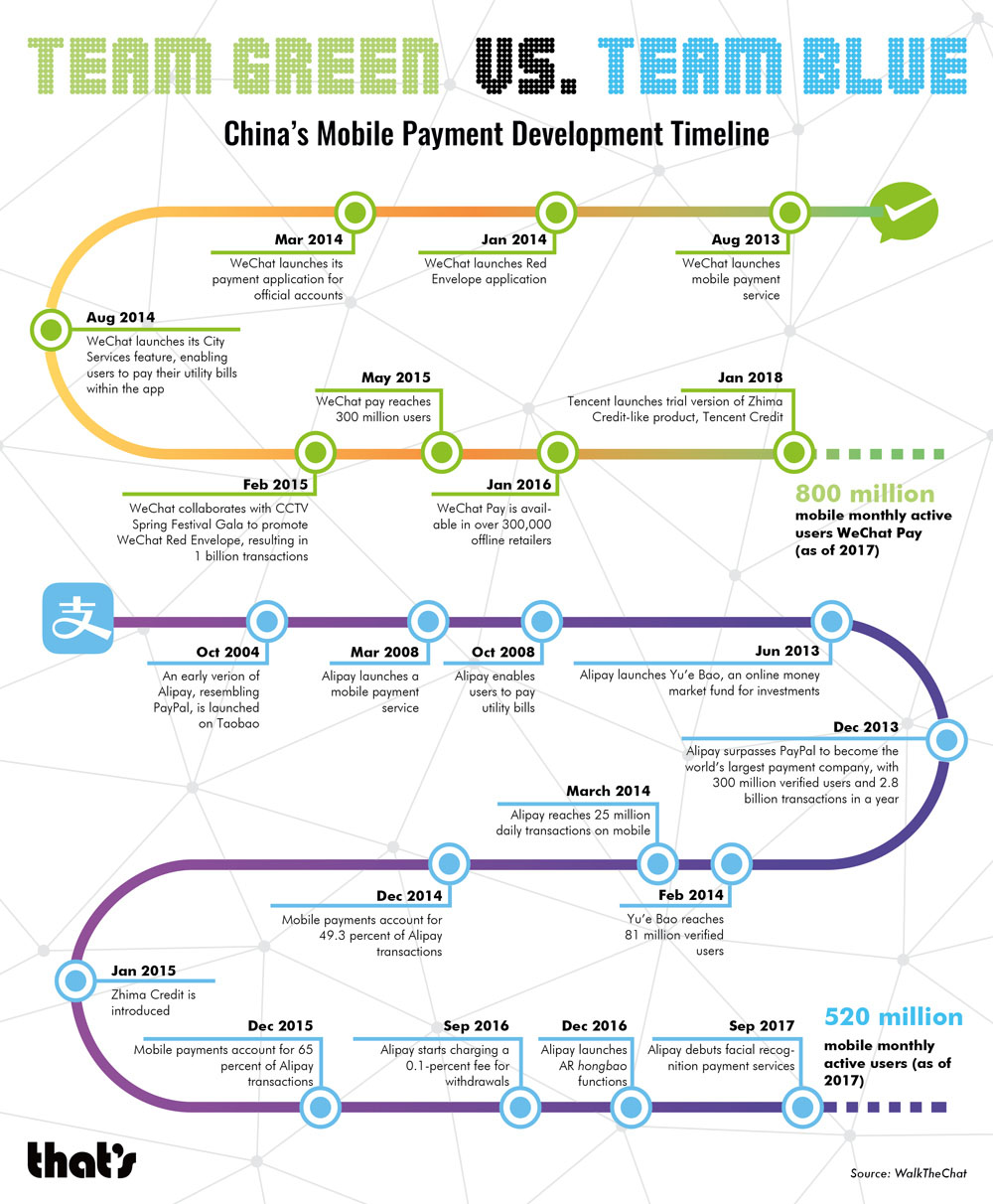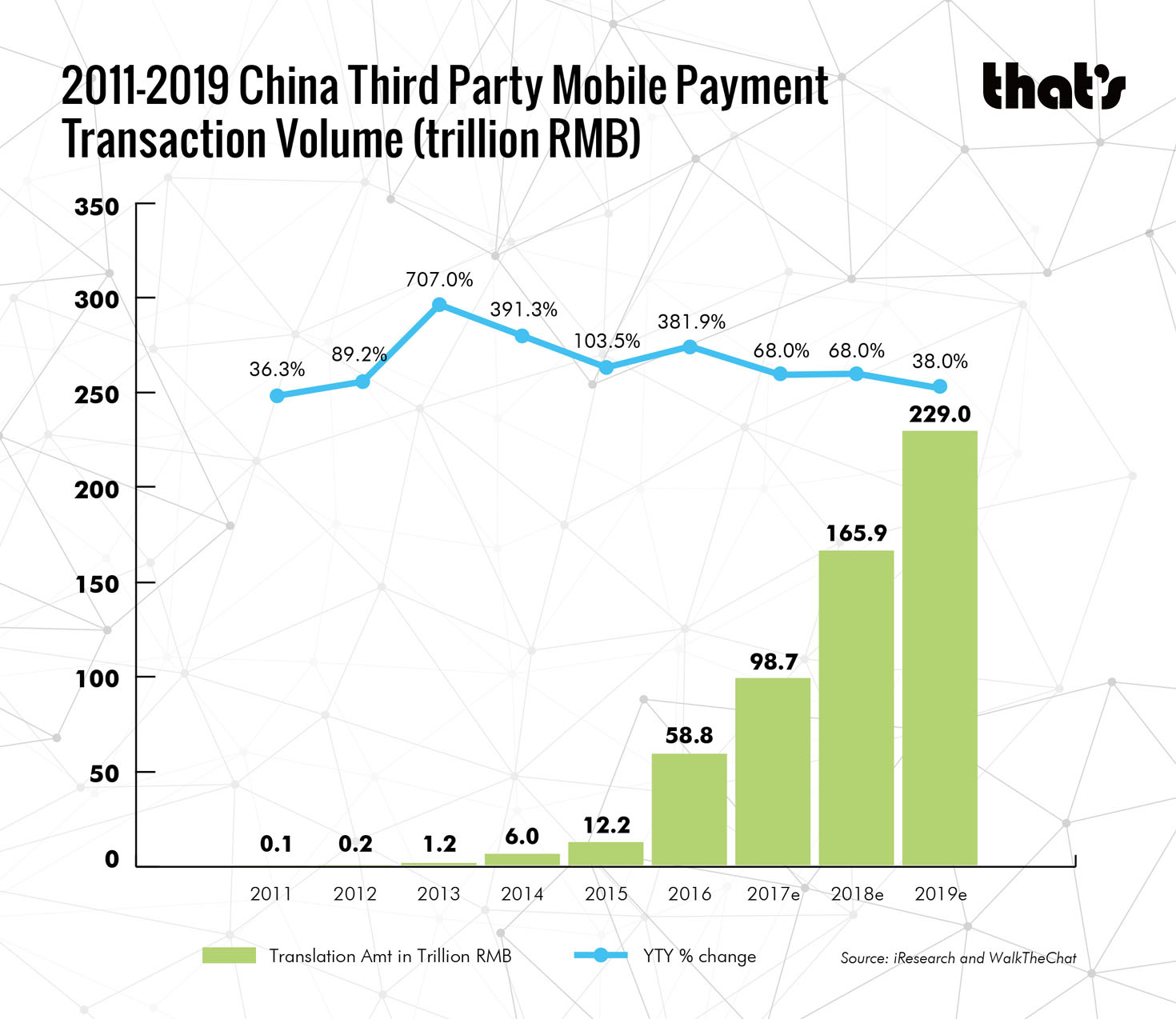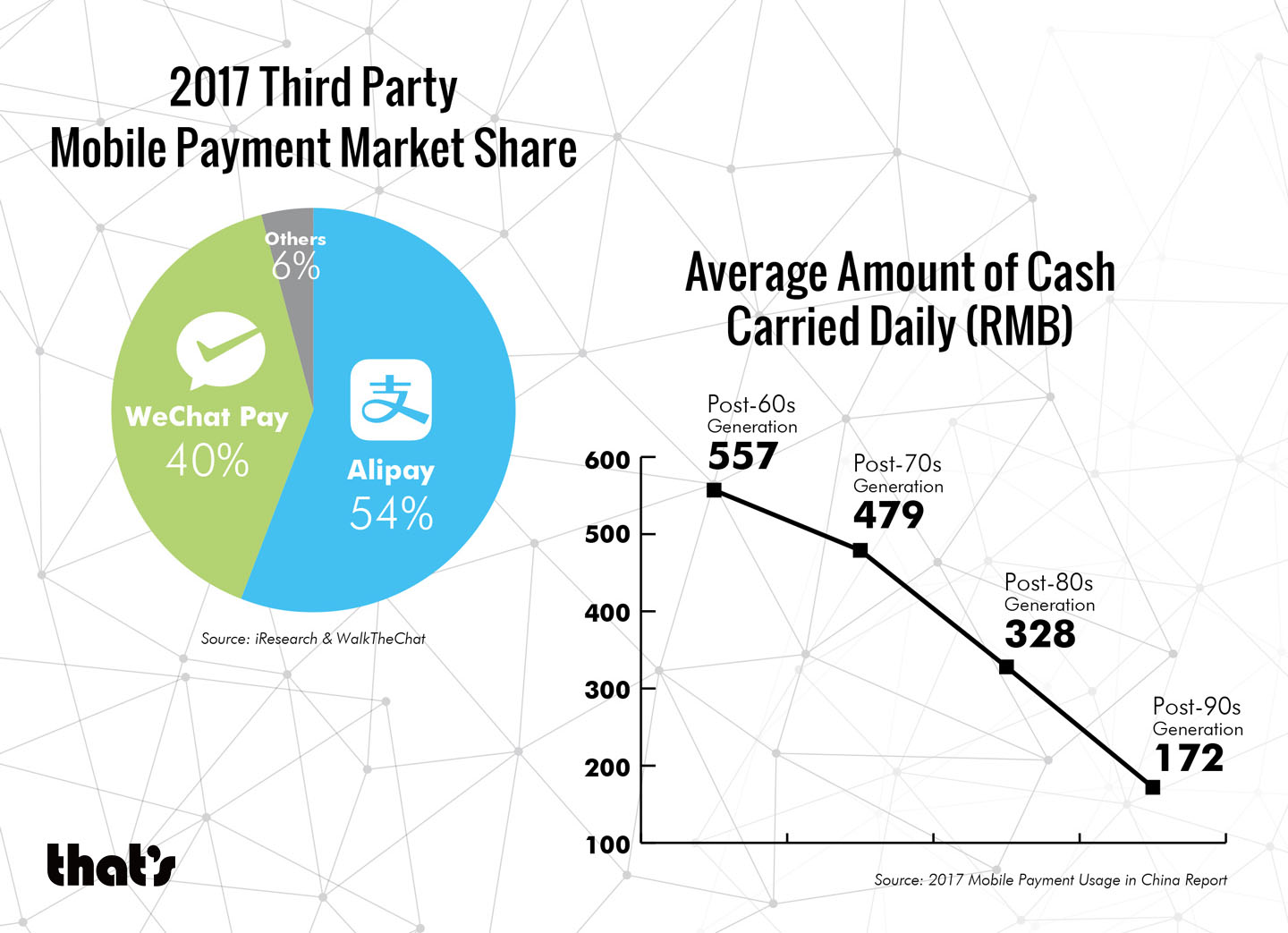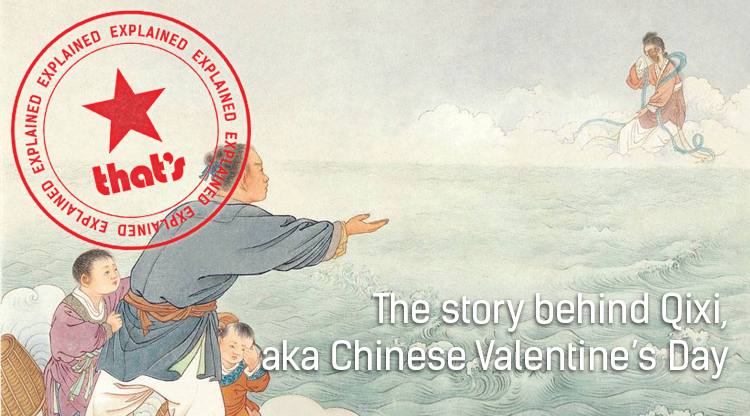On almost every street corner and in the ever-expanding ecommerce marketplace, businesses in China have already fully embraced the convenience of mobile payment. But as the nation dashes full speed ahead in the direction of becoming a cashless society, have we fully considered the pros and cons of digitizing our bills and coins?
Scan and Go

Carrying a physical wallet in a ‘QR code first economy’ like China is a hassle. For everyday transactions, a smartphone and an Alipay or WeChat Pay account connected to your local bank account are basically all you need. To pay, you just have to scan the merchants’ QR code with these apps, or have them scan yours. Easy, breezy.
“Maybe about seven out of 10 people scan QR codes to pay. Others use their cards,” says Ji, the middle-aged ayi from Hunan who manages the corner store next to my apartment while I scan the QR code displayed on the counter with WeChat to pay for some fruit. “I receive cash maybe just a handful of times a week.” Moments later, a robotic female voice from her Xiaomi smartphone declares, “Payment is successful, 13 yuan.” Ayi switches her focus back to a soap opera on her Tudou app.
According to official data, China’s mobile payment transactions reached RMB81 trillion over the first 10 months of 2017, an increase of almost 30 percent compared to the total amount recorded in 2016 (RMB58.8 trillion).
Ben Cavender, principal at China Market Research (CMR), believes that besides the added convenience for consumers and merchants, timing has played a critical role in propelling the Middle Kingdom and its 1.4 billion citizens ahead of the rest of the world in mobile payment adoption.
“The growth of China’s middle-class population coincided with the rising popularity of smartphones,” he explains from his Shanghai office. “People who didn’t previously own any electronic goods suddenly have iPhones in their hands. It’s their primary tool and initiation point for technology, whereas in the West, a lot of older consumers who grew up with their desktops and laptops still primarily use those for their online activities.”
At present, China’s two major players in the mobile payment space, Alipay and WeChat Pay, hold about 54 and 40 percent of the market share respectively, according to a 2017 iResearch report. China Channel cofounder Matthew Brennan attributes their dominance to the strengths of their parent companies, ecommerce giant Alibaba, and Tencent, the world’s most valuable social network conglomerate.

Click image to enlarge the timeline. Source: WalkTheChat
Since its introduction in 2004, Alipay has always been the preferred payment solution for any Taobao or Tmall purchases. For nearly a decade, Alipay enjoyed almost a total monopoly in China’s electronic payment game until WeChat Pay came along in 2013.
Competition heated up when Tencent collaborated with the CCTV Spring Festival Gala to launch WeChat Red Envelope on Chinese New Year’s Eve of 2015. The infamous publicity stunt resulted in 1 billion hongbao transactions across the nation, making the platform a formidable opponent to Alipay.
With WeChat being China’s dominant instant messaging platform, Cavender says its offerings resonate with how today’s Chinese consumers use the internet and social media, hence its ‘stickiness’ makes it slightly easier to integrate with people’s daily lives.
Brennan adds, “Both platforms, however, have successfully adapted themselves into the virtual world and into the offline economy… at the end of the day, I don’t think it’s about one winning or losing, as both are well-equipped to thrive in the market.”
A Tighter Leash

The US might be the world’s largest economy, but when it comes to mobile payment, the Chinese are way ahead. China’s total mobile payment transaction revenue was 50 times more than their American counterparts in 2016. Meanwhile, 52 percent of Chinese say less than 20 percent of their monthly transactions are conducted with bills and coins, according to the ‘2017 Mobile Payment Usage in China’ study published by China Tech Insights.
Credit card companies and many Westerners’ ingrained habit of using cards as their primary payment option have prevented mobile payments from taking off, according to Brennan and Cavender. In a country where Visa, Mastercard and American Express still have yet to fully penetrate through the masses, Chinese consumers were able to easily move on from cash and plug themselves directly into the ecosystem that Alipay and WeChat Pay have created.
The downside of this arrangement, Cavender points out, is that tech companies are not held to the same fiduciary standards that traditional financial institutions follow: “At the end of the day, your money is being handled by companies whose main objective is to sell you all sorts of services. There’s definitely a conflict of interest [that works against consumers].”
By signing up for WeChat Pay or Alipay, users are not only giving Tencent and Alibaba instant access to their online shopping behaviors, but also their offline spending habits too, not to mention their personal identity information and how much savings they have in their bank accounts.

The government, which was originally quite hands off during the early stages of the development of mobile payment platforms, has another concern. Up until recently, Alipay and WeChat Pay transactions were set up so that they could deal directly with individual banks while bypassing the central bank’s clearing system entirely.
By June 30, 2018, however, third-party online payment companies and commercial banks will have to migrate this whole process to a People’s Bank of China-backed platform called Wanglian (Non-Bank Internet Payment Union), which essentially allows Chinese monetary authorities to monitor all mobile transactions and data to prevent money laundering, tax evasion or other illegal activities in real time. The migration process had already begun in October 2017, as ordered by the national bank.
Hypothetically, if China were to become 100-percent cashless in the future, this would mean that in addition to having the transaction records between people and businesses, the government would also know the exact amount of money in circulation, and perhaps even be able to monitor the outflow of capital. Yes, Big Brother is watching.
The Fear of Losing Cash

One of the loudest arguments against a digital-only economy is summed up by the headline of Peter Guy’s South China Morning Post op-ed piece published last October: “A cashless society would destroy our privacy and freedom.”
For the Chinese-American venture capitalist and former international banker, the way in which mainlanders have “blindly surrendered their privacy” for the convenience of mobile payment is “gullible and naïve.” “Think of it this way: Cash is the original cryptocurrency,” Guy says. “I don’t want the government to have records of everything that I buy, or every place that I go. Cash is private, and I always want to have the option of having banknotes under my pillow.”
A firm supporter of the Second Amendment to the Constitution of the United States, Guy even goes as far as equating cash to guns as the last line of defense for one’s freedom and privacy. While the analogy might be a bit extreme, economists agree that a 100-percent cashless economy could have some serious underlying consequences.
Back in 2014 and 2016, central banks of several European nations and Japan had imposed negative interest rates as a desperate economic recovery measure to increase spending and spur inflation. In a hypothetical total cashless world, having all of your savings locked in a computerized system and without the option of cash withdrawal means there’s no way to avoid getting penalized for simply leaving your savings in the bank.
Moreover, natural disasters and blackouts could cause mass panic if people wouldn’t be able to access their money. Last but not least, a fully digitized economy would leave those who cannot afford a smartphone or seniors who are technologically challenged worse off.
But for many countries, an entirely cashless economy is still a long ways away. In China, for instance, cash still makes up a significant chunk of the Chinese economy – 66 trillion yuan in 2016, according to a central bank payments report. Though the number has been decreasing in recent years, completely eliminating cash will be difficult in practice, CMR’s Cavender says. “Realistically, I don’t think cash will go away entirely, but it will certainly be relegated to a less important role.”
That, however, might be a different story for one Scandinavian country.
Niklas Arvidsson had to think for a moment before he could recall the last time he used cash when we spoke via Skype (a Swedish invention, he points out). The economics professor at Stockholm’s KTH Royal Institute of Technology has been following the diminishing usage of cash in his country for some time. In a 2017 study, Arvidsson and his team point to the exact date when Swedish merchants will stop accepting cash completely – March 24, 2023.
While China might be leaps and bounds ahead of the rest of the world in mobile payment usage, Sweden is leading the pack in terms of having the lowest value of cash in circulation in the world. As of 2016, just 1.4 percent of its gross domestic product is cash-based, which is significantly lower than the global average of 9 percent, according to a 2016 Bank of International Settlements report.

Click image to enlarge. Source: iResearch and WalkTheChat
In its major cities, ‘no cash’ signs are becoming common decor at the entrances of shops, cafes and restaurants. Unlike many countries though, it’s completely legal for Swedish merchants to refuse cash.
Weeks ago, Bloomberg reported that remote parts of the country are now at risk of losing access to banknotes, prompting distressed cash-handling industry lobbyists and officials from the Swedish central bank, Riksbank, to call for new legislation to safeguard the existence of cash. Later this summer, Riksbank will also be publishing a special report outlining the systemic risks the country could potentially face if banknotes and coins were to disappear completely.
“The cost of cash transactions is always higher than electronic. Through our survey with some of the country’s most cash-intensive merchants, we found that while 97 percent of them still accept cash, only 18 percent of all transactions are carried out via banknotes and coins,” explains Arvidsson.
Through extrapolating other data points, the survey suggests that when the total cash transactions drop below 7 percent, then the cost of processing them will exceed its profits, rendering it an economically unviable option for businesses to receive cash. After analyzing the projections of the country’s rising non-cash payments, Arvidsson’s estimate is that Sweden could potentially enter into an era of total cashlessness in less than five years.
This estimate, the professor stresses, is a pure economic theory. “To become [an entirely cashless economy], a lot of political and legal factors need to come into play,” he says. This would include a complete overhaul of banking laws – a process that’s likely to take much longer than five years.
But like many Western countries, the Swedes still rely heavily on plastic – 71 percent of retail transactions are paid via debit or credit card. At the moment, there’s no Swedish equivalent of Alipay or WeChat Pay in place. There is Swish, a popular mobile payment app currently used by around half of the country’s population, but its functions are currently limited to peer-to-peer transactions.
CMR’s Cavender thinks China’s willingness to embrace technological innovations could allow the country to beat Sweden in the race to become fully cashless. “QR codes are a much more powerful tool that allows people like a small baozi vendor to operate with very low overhead costs, whereas businesses in Sweden still have to invest in old school card payment processing systems,” he comments. “From a technology standpoint, what the Chinese are doing with mobile payment solutions is definitely way more interesting.”
Though when asked whether the Swedes are concerned with the security of their personal information and privacy, Arvidsson’s answer gives us a lot to think about: “Swedish people believe in the legal system and the government’s data protection directives. A majority of people here aren’t overly concerned.”
Open Sesame

On January 19, a text message from an unknown number tells me I’m eligible for a RMB50,000 loan (“low interest! quick approval process!”). Another message a few days later from an associate of ‘Daimler Investments’ (unrelated to the German automobile manufacturer) reads, “We help our clients make more money with money, 10,000 becomes 30,000, earning 100,000 a month isn’t a dream anymore!”
And it seems like these random investment pitches are running wild. Chinese consumers have been receiving more and more loan offers via WeChat and SMS in recent years, causing the country’s short-term credit rate to jump by 160 percent in the first eight months of 2017, according to the Wall Street Journal.
Up until recently, the Middle Kingdom lacked a functioning credit rating system. In June 2014, the Chinese government announced a Social Credit System initiative that will assign a rating to each citizen based on one’s financial records and social behaviors. While basic structures of this nationwide system are expected to be in place by 2020, private companies have already been running trial programs over the past few years. According to China Tech Insight’s report, improving financial credit ratings through the consumer data collected is a major initiative for mobile payment platforms over the next few years.
Seen as the first prototype of the official system to be launched in two years, Zhima Credit (or Sesame Credit) – a product of Ant Financial Services, the Alibaba affiliate that operates Alipay – appeared on the Alipay app homescreen alongside taxi booking and food delivery functions months after the government’s 2014 announcement. Once registered, users are given a score from 350 to 950 based on information in five categories that the mobile payment app already has on its 520 million users: identity (occupation, education level), assets (savings, properties, cars), history (timeliness of credit card payments), network (the number and quality of Alipay contacts) and behavior (transactions made with Alipay). Tencent Credit, a similar rating system created by the eponymous parent company of WeChat, was also rolled out in mid-2017.

Click image to enlarge. Source: iResearch, WalkTheChat, 2017 Mobile Payment Usage in China Report
At the beginning of this year, thousands of Alipay users were furious after finding out their Zhima Credit scores appeared on an animated Alipay annual usage report without their prior consent, prompting the credit rating service provider to issue an official apology on its Weibo account.
Zhou Min, a 20-something fresh grad who works in advertising, was one of the victims of the privacy invasion snafu, though her attitude is relatively more chill than some. “I’m pretty sure they probably already have my spending data because I’ve been using Alipay regularly for a few years,” she says. “That wouldn’t surprise me at all.”
At this point, scores on Zhima Credit or Tencent Credit only offer a snapshot of the users’ spending behaviors within Alibaba or Tencent’s own mobile payment ecosystems. But once the government-sponsored system is up and running by 2020, experts say it could be the most powerful ‘mass surveillance’ meets ‘big data analysis tool’ in the world – and our smartphones could very well become the surveillance device that’s tagged onto all of us.
When I ask Zhou whether she’s concerned if such a powerful system were to be put in place two years later, her answer, while similar to Arvidsson’s, strikes a different tone. “I’m not worried… It’s not like we can opt out or anything.”
Too Late to Go Back
While 2020 is still two years away, our addiction to the convenience of mobile payment apps most likely won’t go away anytime soon. At the corner store near my apartment, Ji’s not in a good mood. A young security guard is paying for a RMB10 pack of Zhong Nan Hai with a 100 kuai bill. As the ayi counts the change, she mutters some words in her local dialect, and then asks loudly in Mandarin, “People don’t use these anymore,” pointing to the crumbled notes on the counter, “why are you still paying with these?”
As the guard walks out, ayi gives him one last death stare as if he’s violated some sort of unspoken etiquette rule for payment procedures on her turf. She returns to her smartphone, presses play, and the loud characters from her favorite soap opera carry on their conservation mid-sentence. Not wanting to interrupt her show, I silently pay for my water with WeChat. Voices of the actors dim for a moment, in exchange for the robotic WeChat Pay lady: “Payment is successful, 20 yuan.” Her eyes are still glued to the screen as I walk out.






















0 User Comments